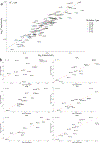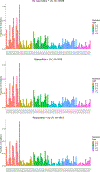Error-prone bypass of DNA lesions during lagging-strand replication is a common source of germline and cancer mutations
- PMID: 30510240
- PMCID: PMC6317876
- DOI: 10.1038/s41588-018-0285-7
Error-prone bypass of DNA lesions during lagging-strand replication is a common source of germline and cancer mutations
Abstract
Studies in experimental systems have identified a multitude of mutational mechanisms including DNA replication infidelity and DNA damage followed by inefficient repair or replicative bypass. However, the relative contributions of these mechanisms to human germline mutation remain unknown. Here, we show that error-prone damage bypass on the lagging strand plays a major role in human mutagenesis. Transcription-coupled DNA repair removes lesions on the transcribed strand; lesions on the non-transcribed strand are preferentially converted into mutations. In human polymorphism we detect a striking similarity between mutation types predominant on the non-transcribed strand and on the strand lagging during replication. Moreover, damage-induced mutations in cancers accumulate asymmetrically with respect to the direction of replication, suggesting that DNA lesions are resolved asymmetrically. We experimentally demonstrate that replication delay greatly attenuates the mutagenic effect of ultraviolet irradiation, confirming that replication converts DNA damage into mutations. We estimate that at least 10% of human mutations arise due to DNA damage.
Conflict of interest statement
Competing Financial Interests
Authors declare no financial interest
Figures





References
-
- Chen C-L et al. Replication-associated mutational asymmetry in the human genome. Mol. Biol. Evol 28, 2327–2337 (2011). - PubMed
Publication types
MeSH terms
Substances
Grants and funding
LinkOut - more resources
Full Text Sources

